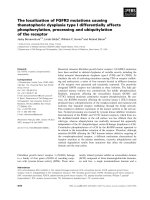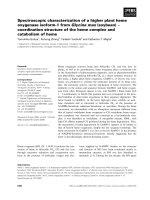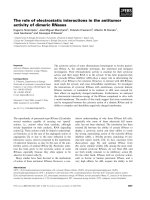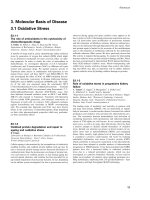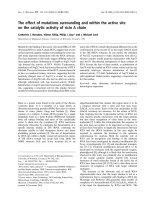Báo cáo khoa học: "The epidemiology of severe sepsis in England, Wales and Northern Ireland, 1996 to 2004: secondary analysis of a high quality clinical" pps
Bạn đang xem bản rút gọn của tài liệu. Xem và tải ngay bản đầy đủ của tài liệu tại đây (1.03 MB, 10 trang )
Open Access
Available online />Page 1 of 10
(page number not for citation purposes)
Vol 10 No 2
Research
The epidemiology of severe sepsis in England, Wales and
Northern Ireland, 1996 to 2004: secondary analysis of a high
quality clinical database, the ICNARC Case Mix Programme
Database
David A Harrison
1
, Catherine A Welch
1
and Jane M Eddleston
2
1
Intensive Care National Audit & Research Centre (ICNARC), Tavistock House, Tavistock Square, London WC1H 9HR, UK
2
Manchester Royal Infirmary, Oxford Road, Manchester M13 9WL, UK
Corresponding author: David A Harrison,
Received: 25 Oct 2005 Revisions requested: 5 Dec 2005 Revisions received: 6 Feb 2006 Accepted: 14 Feb 2006 Published: 10 Mar 2006
Critical Care 2006, 10:R42 (doi:10.1186/cc4854)
This article is online at: />© 2006 Harrison et al.; licensee BioMed Central Ltd.
This is an open access article distributed under the terms of the Creative Commons Attribution License ( />),
which permits unrestricted use, distribution, and reproduction in any medium, provided the original work is properly cited.
Abstract
Introduction To evaluate the impact of recent evidence-based
treatments for severe sepsis in routine clinical care requires an
understanding of the underlying epidemiology, particularly with
regard to trends over time. We interrogated a high quality
clinical database to examine trends in the incidence and
mortality of severe sepsis over a nine-year period.
Methods Admissions with severe sepsis occurring at any time
within 24 hours of admission to critical care were identified to an
established methodology using raw physiological data from the
Intensive Care National Audit & Research Centre (ICNARC)
Case Mix Programme Database, containing data from 343,860
admissions to 172 adult, general critical care units in England,
Wales and Northern Ireland between December 1995 and
January 2005. Generalised linear models were used to assess
changes in the incidence, case mix, outcomes and activity of
these admissions.
Results In total, 92,672 admissions (27.0%) were identified as
having severe sepsis in the first 24 hours following admission.
The percentage of admissions with severe sepsis during the first
24 hours rose from 23.5% in 1996 to 28.7% in 2004. This
represents an increase from an estimated 18,500 to 31,000
admissions to all 240 adult, general critical care units in
England, Wales and Northern Ireland. Hospital mortality for
admissions with severe sepsis decreased from 48.3% in 1996
to 44.7% in 2004, but the total number of deaths increased from
an estimated 9,000 to 14,000. The treated incidence of severe
sepsis per 100,000 population rose from 46 in 1996 to 66 in
2003, with the associated number of hospital deaths per
100,000 population rising from 23 to 30.
Conclusion The population incidence of critical care admission
with severe sepsis during the first 24 hours and associated
hospital deaths are increasing. These baseline data provide
essential information to those wishing to evaluate the
introduction of the Surviving Sepsis Campaign care bundles in
UK hospitals.
Introduction
Severe sepsis is a syndrome characterised by systemic inflam-
mation, coagulopathy and acute organ dysfunction in
response to infection [1]. The published mortality associated
with the disease has reduced slightly in the past 10 to 15
years, almost certainly a reflection of improved supportive clin-
ical care, but still remains high (30% to 50%) [2]. This reduc-
tion is evident from comparative outcomes in placebo groups
of large randomised studies in severe sepsis [3-6]. The chal-
lenge is to achieve outcomes for patients that are consistent
with the treatment limbs of these recent studies. Recent treat-
ment modalities that have established their efficacy in patients
with severe sepsis include drotrecogin alfa (activated) [5] and
early goal-directed therapy [7]. The widespread adoption of
such evidence-based practice into clinical care has been dis-
appointingly slow, despite the quantifiable benefits of a 6.1%
absolute reduction in 28-day mortality with drotrecogin alfa
APACHE = Acute Physiology and Chronic Health Evaluation; HDU = high dependency unit; ICD = International Classification of Diseases ICNARC
= Intensive Care National Audit & Research Centre; ICU = intensive care unit; PROWESS = Protein C Worldwide Evaluation in Severe Sepsis; SIRS
= systemic inflammatory response syndrome.
Critical Care Vol 10 No 2 Harrison et al.
Page 2 of 10
(page number not for citation purposes)
(activated) [5] and a 16% absolute reduction in hospital mor-
tality with early goal-directed therapy [7].
The Surviving Sepsis Campaign was developed in an attempt
to address the clinical inertia in the adoption of such evidence-
based strategies [8]. The campaign has worldwide support
from professional societies and has gained consensus on the
management of patients with severe sepsis. The guidelines
have subsequently been deployed in two bundles, with the
components in each bundle sharing a common relationship in
time.
Clinical experience to date would suggest that the inclusion of
evidence-based strategies into bundles, which facilitate a
drive to change by the reduction of omissions of clinical care,
will be the key to effective change in practice [9]. Quantifying
the full impact of these changes will require a longitudinal
understanding of the underlying epidemiology of severe sep-
sis in the population. It is important to know not only baseline
data, such as the incidence of severe sepsis and associated
mortality, but also trends in these data over time, so that any
change can be evaluated relative to these trends. Many recent
studies have explored the epidemiology of severe sepsis in dif-
ferent populations [10]; however, most of these studies had a
short time frame and were unable to describe changes over
time.
We present data from an analysis of a database arising from a
national audit of patient outcomes from critical care units in
England, Wales and Northern Ireland. Data from this database
have previously been used to establish baseline epidemiology
for severe sepsis in the UK [11,12]. When these analyses
were performed, however, only four years' data were available,
limiting the usefulness of comparisons over time. The increas-
ing amount of data from this ongoing audit means that a more
complete analysis of time trends is now possible. In this article,
we present an analysis of the changes in the epidemiology of
severe sepsis presenting within 24 hours of admission to crit-
ical care in England, Wales and Northern Ireland. The data
cover the nine-year period from 1996 to 2004.
These results were presented at the Surviving Sepsis Cam-
paign: Launch of the Care Bundles in England, Manchester
Royal Infirmary, 13 June 2005.
Materials and methods
Case Mix Programme Database
The Case Mix Programme Database is a high quality clinical
database containing data on demographics, case mix, out-
come and activity for admissions to adult, general critical care
Figure 1
Percentage of admissions with severe sepsis during the first 24 hours following admission to critical care, 1996 to 2004Percentage of admissions with severe sepsis during the first 24 hours
following admission to critical care, 1996 to 2004. Percentage for each
year with 95% confidence interval.
Table 1
Admissions with severe sepsis during the first 24 hours following admission to critical care
Number of critical care
units
Unit-years of data Total number of
admissions
Admissions with severe
sepsis (%)
1996 61 39.6 14,696 3,458 (23.5)
1997 76 67.4 25,486 6,007 (23.6)
1998 94 85.1 34,033 8,638 (25.4)
1999 103 94.5 38,567 10,257 (26.6)
2000 111 98.6 39,437 10,923 (27.7)
2001 129 110.4 47,688 13,325 (27.9)
2002 148 134.2 59,388 16,285 (27.4)
2003 151 129.3 59,527 16,594 (27.9)
2004 100 54.7 24,905 7,145 (28.7)
Total
a>
172
b
814.0 343,860 92,672 (27.0)
a
Total includes 55 admissions from 1995 and 78 admissions from 2005;
b
172 critical care units contributed data at any time during the study.
Available online />Page 3 of 10
(page number not for citation purposes)
units participating in the Case Mix Programme. The Pro-
gramme provides a national comparative audit of critical care
for England, Wales and Northern Ireland and is co-ordinated
by the Intensive Care National Audit & Research Centre (ICN-
ARC) [13]. Patient data are abstracted by trained data collec-
tors according to precise rules and definitions, and are subject
to both local and central validation before being pooled into
the database. The database includes physiology data from the
first 24 hours following admission to the critical care unit and
reason for admission to the critical care unit. In total, data for
343,860 admissions to 172 critical care units between
December 1995 and January 2005 were available for analysis.
The critical care units included intensive care units (ICUs) and
combined ICU/high dependency units (HDUs), but not stand-
alone HDUs.
Selection of cases
Admissions with severe sepsis during the first 24 hours in the
critical care unit were identified using physiological criteria
derived from those used in the Protein C Worldwide Evalua-
tion in Severe Sepsis (PROWESS) study of drotrecogin alfa
(activated), as described previously [12]. Briefly, severe sepsis
was defined as evidence of infection plus three or more sys-
temic inflammatory response syndrome (SIRS) criteria [1] and
at least one organ dysfunction (cardiovascular, respiratory,
renal, haematological or metabolic) during the 24-hour period.
This diagnosis of sepsis was based on raw physiological data.
Analyses
The total number of admissions with severe sepsis within 24
hours of admission to critical care and percentage of all admis-
sions was calculated for each year from 1996 to 2004. For
admissions with severe sepsis, the case mix, outcome and
activity were described for each year.
Case mix was measured by age, sex, severe comorbidities,
surgical status (admissions direct from theatre following elec-
tive or emergency surgery, and non-surgical admissions), pre-
admission critical care (transfers from another ICU or HDU,
and those managed on the ward by the critical care team prior
Figure 2
Changes in case mix for admissions with severe sepsis during the first 24 hours following admission to critical care, 1996 to 2004Changes in case mix for admissions with severe sepsis during the first 24 hours following admission to critical care, 1996 to 2004. *Surgical status:
L, elective; M, emergency; N, non-surgical. CI, confidence interval; HDU, high dependency unit; ICU, intensive care unit.
Critical Care Vol 10 No 2 Harrison et al.
Page 4 of 10
(page number not for citation purposes)
to admission to the critical care unit), reason for admission to
the critical care unit, Acute Physiology and Chronic Health
Evaluation (APACHE) II score [14], number of organ dysfunc-
tions, and summaries of individual physiological variables. Out-
come was measured by the mortality in the critical care unit,
transfers out of the critical care unit for ongoing care in another
ICU or HDU, and the mortality at ultimate discharge from an
acute hospital, both overall and by surgical status. Activity was
measured by the length of stay in the critical care unit (by sur-
vival status), the percentage of critical care unit bed-days
occupied by admissions with severe sepsis, and the total
length of stay in hospital (by survival status).
Trends over time were tested using generalised linear models:
logistic regression for binary variables (admissions with severe
sepsis, sex, mortality); linear regression for changes in means
(age, APACHE II score); ordered logistic regression for
ordered categorical data (number of organ dysfunctions); and
multinomial logistic regression for unordered categorical data
(surgical status, pre-admission critical care, critical care trans-
fers). Median regression was used to test for changes in
median lengths of stay. All generalised linear models were fit-
ted with robust (Huber-White) standard errors adjusted for
clustering on critical care unit [15].
Population incidence
The projected total numbers of admissions aged 16 years or
over to adult, general critical care units in England, Wales and
Northern Ireland for each year were estimated by extrapolating
the number of observed admissions to 240 critical care units
identified from the Directory of Critical Care [16]. Confidence
intervals were estimated by bootstrapping [17]. The projected
numbers of admissions were converted to population (treated)
incidences by dividing by population estimates obtained from
National Statistics [18]. Population estimates were not availa-
ble for the year 2004.
All analyses were performed using Stata 8.2 (StataCorp LP,
College Station, TX, USA). P < 0.05 was considered to repre-
sent a statistically significant result.
Results
Of the 343,860 admissions between December 1995 and
January 2005, 92,672 (27.0%) were identified as having
severe sepsis during the first 24 hours following admission to
the critical care unit. The breakdown of the data by year is
shown in Table 1. Fifty-five admissions from December 1995
and 78 admissions from January 2005 were included in the
totals, but excluded from all analyses by year. The proportion
of admissions with severe sepsis during the first 24 hours
increased from 23.5% in 1996 to 28.7% in 2004 (P = 0.004;
Figure 1).
Figure 2 shows changes in the case mix of admissions with
severe sepsis during the first 24 hours following admission to
the critical care unit between 1996 and 2004. The mean age
of admissions rose from 59.5 years in 1996 to 62.2 years in
2004 (P < 0.001). The sex distribution remained approxi-
mately constant (P = 0.062), with around 54% of admissions
being male. A decreasing proportion of patients were admitted
Table 2
Changes in components of the SIRS criteria for admissions with severe sepsis during the first 24 hours following admission to
critical care, 1996 to 2004
Highest central
temperature
a
(°C)
Highest heart rate
(min
-1
)
Highest non-
ventilated
respiratory rate
b
(min
-1
)
Lowest PaCO
2
(kPa)
Mechanically
ventilated, n (%)
Lowest white
blood cell count
(× 10
9
l
-1
)
1996 38.2 (37.5–38.8) 127 (112–145) 28 (21–36) 4.5 (3.9–5.2) 2,733 (81.0) 11.1 (6.9–15.8)
1997 38.1 (37.5–38.8) 126 (112–144) 28 (22–36) 4.5 (3.9–5.2) 4,744 (79.0) 11.3 (6.9–16.1)
1998 38.1 (37.5–38.7) 125 (110–141) 28 (22–35) 4.5 (3.9–5.3) 6,893 (79.9) 11.3 (7.0–15.9)
1999 38.1 (37.5–38.8) 125 (110–140) 28 (22–36) 4.6 (3.9–5.3) 8,114 (79.1) 11.4 (7.1–16.1)
2000 38.0 (37.4–38.7) 125 (110–140) 28 (22–35) 4.6 (4.0–5.3) 8,624 (79.0) 11.5 (7.1–16.3)
2001 38.0 (37.4–38.7) 124 (110–140) 28 (22–35) 4.6 (4.0–5.4) 10,146 (76.3) 11.8 (7.4–16.6)
2002 38.0 (37.4–38.6) 122 (108–138) 28 (23–36) 4.6 (4.0–5.4) 11,904 (73.7) 11.8 (7.4–16.6)
2003 38.0 (37.4–38.6) 121 (108–138) 29 (23–36) 4.7 (4.0–5.4) 11,986 (73.1) 11.8 (7.3–16.8)
2004 38.0 (37.4–38.7) 120 (107–135) 29 (23–36) 4.6 (4.0–5.4) 5,141 (73.1) 11.9 (7.3–17.0)
Total
c
38.0 (37.4–38.7) 124 (110–140) 28 (22–36) 4.6 (4.0–5.4) 70,317 (76.4) 11.6 (7.2–16.5)
Values are median (interquartile range) of the most extreme physiological measurement from the first 24 hours following admission to critical care,
unless otherwise stated.
a
Non-central temperature +0.5°C used as a substitute for central temperature in admissions with no central temperature
recorded.
b
For admissions that were not mechanically ventilated for the entire of the first 24 hours following admission to critical care.
c
Total
includes 55 admissions from 1995 and 78 admissions from 2005. PaCO
2
, arterial carbon dioxide tension; SIRS, systemic inflammatory response
syndrome.
Available online />Page 5 of 10
(page number not for citation purposes)
following elective surgery (P = 0.046 relative to non-surgical
admissions), but there was no change in the relative propor-
tions of emergency surgical and non-surgical admissions (P =
0.22). There was a slight decrease in the proportion of admis-
sions with severe sepsis transferred in from another ICU (P =
0.003) and a corresponding increase in the proportion
stepped-up from an HDU (P = 0.036); however, there was no
change in the proportion managed on the ward by the critical
care team prior to admission (P = 0.62). There was no change
in the mean APACHE II score (P = 0.56) or the number of
organ dysfunctions (P = 0.84). Overall, 23% of admissions
had an APACHE II score of 25 or more (indicating a high risk
of death [8]). However, 83% of admissions had multiple organ
failure (two or more organ dysfunctions).
Changes in the individual physiological measurements con-
tributing to the SIRS criteria, markers of organ dysfunction,
and laboratory measurements are shown in Tables 2, 3 and 4,
respectively. There have been some slight trends in the physi-
ological measurements over time, although not sufficient to
influence a summary score such as APACHE II. The proportion
of severe sepsis admissions that were mechanically ventilated
during the first 24 hours in ICU has also decreased from 81%
in 1996 to 73% in 2004. Changes in severe comorbidities are
shown in Table 5. There has been a decrease in the proportion
of severe sepsis admissions with severe respiratory or cardio-
vascular comorbidities and a slight increase in liver comorbid-
ities.
The most commonly recorded primary reasons for admission
to ICU were pneumonia (22.6%), septicaemia/septic shock
(11.8%), bowel perforation or rupture (10.5%), exacerbation
of chronic obstructive pulmonary disease/asthma (5.4%),
meningitis (2.1%) and pancreatitis (1.9%). There was little
change in these reasons for admission over time.
Figure 3 shows changes in unit and hospital outcomes over
time. Mortality in the critical care unit decreased from 34.3%
in 1996 to 30.8% in 2004 (P = 0.013). The proportion trans-
ferred to another ICU remained approximately constant at
around 7% (P = 0.29); however, the proportion transferred to
an HDU increased (P = 0.009). Hospital mortality also
decreased from 48.3% in 1996 to 44.7% in 2004 (P =
0.042). The decrease in hospital mortality was more pro-
nounced in surgical admissions (both elective and emergency)
than non-surgical admissions.
Figure 4 shows changes in activity over time. Length of stay in
the critical care unit was longer for survivors than non-survivors
(median 4.6 versus 3.2 days). This gap widened during the
course of the study period as the median length of stay for sur-
vivors increased and the median length of stay for non-survi-
vors decreased (both P < 0.001). Length of stay for
admissions with severe sepsis was long compared to other
admissions, indicated by the 27% of admissions that had
severe sepsis utilising 46% of all critical care unit bed-days in
these units. Median total length of stay in hospital for survivors
was four weeks, with a small but statistically significant
increase during the study period (P < 0.001). There was no
change in the median hospital length of stay for non-survivors,
which remained constant at 12 days (P = 1.0).
The projected total numbers of adults (age 16 years or over)
admitted to 240 general critical care units in England, Wales
Table 3
Changes in markers of organ dysfunction for admissions with severe sepsis during the first 24 hours following admission to critical
care, 1996 to 2004
Lowest systolic
blood pressure
(mmHg)
Hourly urine
output (ml)
Lowest PaO
2
/
FiO
2
(kPa)
Lowest platelet
count (× 10
9
l
-1
)
Lowest pH Highest base
deficit
1996 85 (78–100) 75 (45–114) 20.0 (12.9–28.9) 170 (104–250) 7.28 (7.19–7.35) 5.1 (1.2–9.7)
1997 86 (75–100) 76 (45–114) 19.7 (12.8–28.6) 175 (106–253) 7.28 (7.19–7.35) 5.0 (1.1–9.5)
1998 87 (75–100) 74 (43–109) 19.7 (13.0–28.3) 171 (106–249) 7.28 (7.19–7.35) 4.8 (0.8–9.3)
1999 90 (77–100) 73 (43–109) 19.9 (12.9–28.9) 177 (109–256) 7.28 (7.18–7.35) 4.9 (0.6–9.4)
2000 90 (78–100) 70 (42–106) 19.3 (12.5–28.0) 184 (110–268) 7.28 (7.19–7.36) 4.7 (0.5–9.2)
2001 90 (79–100) 68 (40–103) 20.0 (12.9–28.8) 197 (122–284) 7.28 (7.18–7.35) 4.9 (0.7–9.5)
2002 90 (80–100) 69 (41–104) 19.7 (12.8–29.0) 202 (126–291) 7.28 (7.18–7.35) 4.9 (0.8–9.3)
2003 90 (79–100) 66 (39–101) 19.8 (12.7–28.8) 199 (124–287) 7.28 (7.18–7.35) 5.1 (1.1–9.5)
2004 90 (79–100) 63 (36–98) 19.8 (13.1–29.2) 199 (124–287) 7.27 (7.18–7.35) 4.7 (0.7–9.0)
Total
a
90 (78–100) 69 (41–105) 19.8 (12.8–28.7) 189 (116–274) 7.27 (7.18–7.35) 4.9 (0.8–9.4)
Values are median (interquartile range) of the most extreme physiological measurement from the first 24 hours following admission to critical care.
a
Total includes 55 admissions from 1995 and 78 admissions from 2005. FiO
2
, fraction of inspired oxygen; PaO
2
, arterial partial pressure of
oxygen.
Critical Care Vol 10 No 2 Harrison et al.
Page 6 of 10
(page number not for citation purposes)
and Northern Ireland with severe sepsis during the first 24
hours following admission to the unit, and the corresponding
numbers of hospital deaths, are shown in Figure 5. The
number of critical care admissions with severe sepsis has
risen steeply from 18,500 in 1996 to 31,000 in 2004, and,
despite falling mortality, the total projected deaths has risen
from 9,000 in 1996 to 14,000 in 2004. These figures are pre-
sented as population incidences in Figure 6. The incidence of
critical care admission with severe sepsis during the first 24
hours has risen from 46 per 100,000 adult population in 1996
Table 4
Changes in laboratory measurements for admissions with severe sepsis during the first 24 hours following admission to critical
care, 1996 to 2004
Lowest serum
sodium
(mmoll
-1
)
Lowest serum
potassium
(mmoll
-1
)
Highest serum
creatinine
(µmoll
-1
)
Highest serum urea
(mmoll
-1
)
Lowest serum
albumin
(gl
-1
)
Highest serum
glucose
(mmoll
-1
)
Lowest
haemoglobin
a
(gdl
-1
)
1996 136 (132–139) 3.7 (3.3–4.1) 121 (84–203) 10.2 (6.3–16.9) 23 (18–29) 9.0 (7.0–12.0) 10.2 (8.8–11.6)
1997 136 (132–139) 3.7 (3.3–4.1) 119 (83–203) 10.1 (6.3–17.1) 22 (17–28) 9.0 (7.0–12.0) 10.0 (8.8–11.5)
1998 136 (133–139) 3.7 (3.3–4.1) 118 (82–197) 9.9 (6.0–16.8) 21 (16–27) 8.9 (7.0–11.9) 10.0 (8.7–11.4)
1999 136 (133–139) 3.7 (3.3–4.1) 115 (80–191) 9.9 (6.0–16.7) 19 (15–25) 8.9 (7.0–11.9) 9.9 (8.6–11.3)
2000 136 (133–140) 3.7 (3.4–4.1) 116 (81–197) 10.0 (6.1–17.1) 19 (14–25) 8.8 (7.0–11.5) 9.7 (8.5–11.1)
2001 137 (133–140) 3.8 (3.4–4.2) 116 (79–195) 10.0 (6.1–16.8) 19 (14–25) 8.6 (6.9–11.3) 9.8 (8.5–11.3)
2002 137 (133–140) 3.8 (3.4–4.2) 113 (80–189) 10.0 (6.0–16.8) 19 (14–25) 8.6 (6.9–11.2) 9.6 (8.3–11.1)
2003 137 (133–140) 3.8 (3.4–4.2) 114 (79–194) 10.0 (6.0–16.8) 19 (14–25) 8.5 (6.8–11.0) 9.5 (8.3–11.0)
2004 137 (133–140) 3.8 (3.4–4.2) 116 (79–194) 9.8 (5.9–16.5) 19 (14–25) 8.5 (6.8–10.8) 9.6 (8.3–11.1)
Total
b
136 (133–140) 3.8 (3.4–4.2) 116 (80–194) 10.0 (6.1–16.8) 20 (15–25) 8.7 (6.9–11.4) 9.7 (8.5–11.2)
Values are median (interquartile range) of the most extreme physiological measurement from the first 24 hours following admission to critical
care.
a
One-third of haematocrit used as substitute for haemoglobin in admissions with no haemoglobin recorded.
b
Total includes 55 admissions
from 1995 and 78 admissions from 2005.
Table 5
Changes in severe comorbities for admissions with severe sepsis during the first 24 hours following admission to critical care, 1996
to 2004
Immunocompromised
a
Respiratory comorbidity
b
Cardiovascular comorbidity
c
Liver comorbidity
d
Renal comorbidity
e
1996 308 (9.1) 231 (7.0) 113 (3.4) 35 (1.1) 60 (1.8)
1997 534 (8.9) 327 (5.6) 161 (2.8) 72 (1.2) 93 (1.6)
1998 714 (8.3) 468 (5.5) 214 (2.5) 134 (1.6) 140 (1.7)
1999 873 (8.5) 480 (4.7) 261 (2.6) 168 (1.7) 172 (1.7)
2000 938 (8.6) 473 (4.4) 243 (2.3) 188 (1.7) 153 (1.4)
2001 1,093 (8.2) 562 (4.2) 262 (2.0) 249 (1.9) 233 (1.8)
2002 1,418 (8.8) 650 (4.1) 323 (2.0) 288 (1.8) 236 (1.5)
2003 1,349 (8.2) 712 (4.4) 292 (1.8) 306 (1.9) 265 (1.6)
2004 615 (8.7) 262 (3.8) 120 (1.7) 104 (1.5) 98 (1.4)
Total
f
7,849 (8.5) 4,167 (4.6) 1,989 (2.2) 1,544 (1.7) 1,450 (1.6)
Values are number (percentage of admissions with evidence available to assess past medical history) presenting with the specified comorbidity.
a
Immunocompromised defined as AIDS, daily steroid treatment for past six months, radiotherapy or chemotherapy within past six months,
metastatic disease, acute or chronic myelogenous or lymphocytic leukaemia, multiple myeloma, lymphoma, or congenital immunohumoral or
cellular immune deficiency state.
b
Respiratory comorbidity defined as shortness of breath with light activity due to pulmonary disease, or using
home ventilation.
c
Cardiovascular comorbidity defined as fatigue, dyspnoea or angina at rest due to myocardial or peripheral vascular disease
(New York Heart Association Functional Class IV).
d
Liver comorbidity defined as biopsy proven cirrhosis, portal hypertension, or hepatic
encephalopathy.
e
Renal comorbidity defined as requirement for renal replacement therapy for irreversible renal disease.
f
Total includes 55
admissions from 1995 and 78 admissions from 2005.
Available online />Page 7 of 10
(page number not for citation purposes)
to 66 per 100,000 adult population in 2003. Associated hos-
pital deaths rose from 23 per 100,000 adult population in
1996 to 30 per 100,000 adult population in 2003.
Discussion
Key findings
The proportion of critical care admissions with severe sepsis
during the first 24 hours rose from 23.5% in 1996 to 28.7% in
2004. Extrapolating to all adult, general critical care units in
England, Wales and Northern Ireland, we estimate that there
were 31,000 admissions with severe sepsis in 2004 (an
increase from 18,500 admissions in 1996). Mortality for
admissions with severe sepsis has decreased despite meas-
ures of severity of illness (APACHE II score, organ dysfunc-
tions) remaining constant, but the total number of deaths has
increased from 9,000 in 1996 to 14,000 in 2004. In popula-
tion terms, the treated incidence of severe sepsis per 100,000
population rose from 46 in 1996 to 66 in 2003, with the asso-
ciated number of hospital deaths per 100,000 population ris-
ing from 23 to 30.
Strengths and weaknesses of this study
The main strength of this study is the use of a large clinical
database with detailed physiological data for the first 24 hours
in ICU. By comparison with studies based on hospital dis-
charge data coded with, for example, International Classifica-
tion of Diseases (ICD) codes [19-21], we were much better
able to match the consensus definitions of severe sepsis. As
the definitions were applied to raw physiological data, this
removed the potential to bias evaluations of trend over time by
changes in the interpretation or application of the definitions
by individuals. However, the data were not collected for the
primary purpose of identifying severe sepsis and some of the
definitions used in the PROWESS study could only be approx-
imated. It was also not possible to identify severe sepsis
occurring later than 24 hours after admission to the critical
care unit. The long time period (nine years) allowed compari-
sons over time that have not been possible in previous studies
of critical care.
A number of other factors may also have affected the results.
The number of units that contributed to the database varied
over time. Some closed, merged or left the programme, while
new units would join the programme and begin to contribute
to the dataset. Hence, variability in the quality of care in differ-
ent units may also contribute, to some extent, to the results.
Severity of disease may also have changed over time, despite
little change in APACHE II scores, as indicated by the
decreasing proportion of patients receiving mechanical venti-
lation. Finally, although sepsis was diagnosed using raw data,
the criteria used by physicians to admit patients into their ICU
may have changed over time. For example, improved recogni-
tion of sepsis may have led to earlier admission of patients with
sepsis, and this may influence the outcome of the admitted
patients.
Comparison with other studies
By comparison with other countries, the percentage of critical
care admissions with severe sepsis in our study is very high.
Other studies have reported a range from 7.9% of admissions
Figure 3
Changes in outcomes for admissions with severe sepsis during the first 24 hours following admission to critical care, 1996 to 2004Changes in outcomes for admissions with severe sepsis during the first 24 hours following admission to critical care, 1996 to 2004. *Surgical sta-
tus: L, elective; M, emergency; N, non-surgical. CI, confidence interval; HDU, high dependency unit; ICU, intensive care unit.
Critical Care Vol 10 No 2 Harrison et al.
Page 8 of 10
(page number not for citation purposes)
in the Slovak Republic [22] and 8.4% in France [23] to 14.8%
in an international cohort [24] and 17.4% in Brazil [25]. This
difference could be due to poor matching of the PROWESS
definitions identifying too many patients as having severe sep-
sis. However, this seems unlikely, as the population incidence
is similar to that reported in other studies (47/100,000 in Nor-
way [20], 54/100,000 in the Netherlands [26], 77/100,000 in
Australia and New Zealand [27], and 75 to 119/100,000 in
the USA [21]). The difference may, therefore, reflect a lower
provision of critical care beds in England, Wales and Northern
Ireland and hence reduced access to critical care for lower risk
patients. By contrast, a further study in the USA reported an
incidence of 153 per 100,000 population [28] – double that
in any other country. This may be due to the significantly higher
provision of critical care beds in the USA compared with else-
where [29], although it may indicate that the ICD codes used
to define sepsis in this study were too general, with more spe-
cific codes used in later studies [21].
Two previous studies have explored trends in the epidemiol-
ogy of severe sepsis over a significant time period [19,21].
Both of these were hospital-based studies from the USA, with
the diagnosis of severe sepsis based on ICD, Ninth Revision,
Clinical Modification (ICD-9-CM) codes. The main results of
these studies were consistent with ours, showing increasing
population incidence of severe sepsis and decreasing mortal-
ity. However, Martin and colleagues [19] also found increasing
numbers of organ failures, whereas we found that in a critical
care setting the proportions remained constant. Further infor-
mation on changes over time can be obtained from two simi-
larly designed studies in French critical care units occurring
eight years apart [23,30]. The percentage of critical care
admissions identified as having severe sepsis increased from
8.4% in 1993 to 14.6% in 2001 – a 74% increase. This was
even greater than the 22% increase over 9 years observed in
our study. They also found a decrease in mortality from 59% in
1993 to 42% in 2001. These studies may, however, be hin-
dered by the use of very short data collection periods at differ-
Figure 4
Changes in activity for admissions with severe sepsis during the first 24 hours following admission to critical care, 1996 to 2004Changes in activity for admissions with severe sepsis during the first 24 hours following admission to critical care, 1996 to 2004. IQR, interquartile
range; LoS, length of stay.
Figure 5
Projected total numbers of admissions to 240 adult, general critical care units in England, Wales and Northern Ireland with severe sepsis during the first 24 hours following admission to critical care and associ-ated hospital deathsProjected total numbers of admissions to 240 adult, general critical
care units with severe sepsis during the first 24 hours following admis-
sion to critical care and associated hospital deaths. Projected total for
each year with 95% confidence interval. Admissions aged < 16 years
and readmissions within the same hospital stay excluded.
Available online />Page 9 of 10
(page number not for citation purposes)
ent times of the year (November to December 1993 and
January to February 2001), as severe sepsis in critical care
units has been shown to have a strong seasonal pattern with
a peak in winter [12]. The trends of an increasing proportion of
admissions with severe sepsis and decreasing mortality in this
study are also consistent with the earlier analysis of the same
database [12].
Conclusion
The population incidence of critical care admission with
severe sepsis during the first 24 hours and associated hospital
deaths are increasing in the UK. In 2004, approximately
31,000 adults admitted to general critical care units had
severe sepsis within 24 hours of admission and 14,000 of
these died before discharge from hospital. These baseline
data provide essential information to those wishing to intro-
duce the recently launched Surviving Sepsis Campaign care
bundles in UK hospitals. Similar analysis in the future, using
data linked to those being collected by the Surviving Sepsis
Campaign, may allow the impact of the sepsis care bundles on
critical care outcomes to be evaluated.
Competing interests
The authors declare that they have no competing interests.
Authors' contributions
DH designed the study, participated in the analysis, and
drafted the manuscript. CW participated in the analysis. JE
conceived the study. All authors were involved in interpretation
of data and critical revision of the manuscript, and have read
and approved the final manuscript.
Acknowledgements
This study was supported by ICNARC. The authors wish to thank every-
one in the ICUs participating in the Case Mix Programme [31].
References
1. Bone RC, Balk RA, Cerra FB, Dellinger RP, Fein AM, Knaus WA,
Schein RM, Sibbald WJ: Definitions for sepsis and organ failure
and guidelines for the use of innovative therapies in sepsis.
The ACCP/SCCM Consensus Conference Committee. Ameri-
can College of Chest Physicians/Society of Critical Care Med-
icine. Chest 1992, 101:1644-1655.
2. Laterre PF, Levy H, Clermont G, Ball DE, Garg R, Nelson DR, Dhai-
naut JF, Angus DC: Hospital mortality and resource use in sub-
groups of the Recombinant Human Activated Protein C
Worldwide Evaluation in Severe Sepsis (PROWESS) trial. Crit
Care Med 2004, 32:2207-2218.
3. Abraham E, Wunderink R, Silverman H, Perl TM, Nasraway S, Levy
H, Bone R, Wenzel RP, Balk R, Allred R: Efficacy and safety of
monoclonal antibody to human tumor necrosis factor alpha in
patients with sepsis syndrome. A randomized, controlled, dou-
ble-blind, multicenter clinical trial. TNF-alpha MAb Sepsis
Study Group. JAMA 1995, 273:934-941.
4. Abraham E, Laterre PF, Garbino J, Pingleton S, Butler T, Dugernier
T, Margolis B, Kudsk K, Zimmerli W, Anderson P, et al.: Lenercept
(p55 tumor necrosis factor receptor fusion protein) in severe
sepsis and early septic shock: a randomized, double-blind,
placebo-controlled, multicenter phase III trial with 1,342
patients. Crit Care Med 2001, 29:503-510.
5. Bernard GR, Vincent JL, Laterre PF, LaRosa SP, Dhainaut JF,
Lopez-Rodriguez A, Steingrub JS, Garber GE, Helterbrand JD, Ely
EW, et al.: Efficacy and safety of recombinant human activated
protein C for severe sepsis. N Engl J Med 2001, 344:699-709.
6. Ziegler EJ, Fisher CJ Jr, Sprung CL, Straube RC, Sadoff JC, Foulke
GE, Wortel CH, Fink MP, Dellinger RP, Teng NN: Treatment of
gram-negative bacteremia and septic shock with HA-1A
human monoclonal antibody against endotoxin. A randomized,
double-blind, placebo-controlled trial. The HA-1A Sepsis
Study Group. N Engl J Med 1991, 324:429-436.
7. Rivers E, Nguyen B, Havstad S, Ressler J, Muzzin A, Knoblich B,
Peterson E, Tomlanovich M: Early goal-directed therapy in the
treatment of severe sepsis and septic shock. N Engl J Med
2001, 345:1368-1377.
8. Dellinger RP, Carlet JM, Masur H, Gerlach H, Calandra T, Cohen
J, Gea-Banacloche J, Keh D, Marshall JC, Parker MM, et al.: Sur-
viving Sepsis Campaign guidelines for management of severe
sepsis and septic shock. Crit Care Med 2004, 32:858-873.
9. Levy MM, Pronovost PJ, Dellinger RP, Townsend S, Resar RK,
Clemmer TP, Ramsay G: Sepsis change bundles: converting
guidelines into meaningful change in behavior and clinical
outcome. Crit Care Med 2004, 32:S595-S597.
10. Linde-Zwirble WT, Angus DC: Severe sepsis epidemiology:
sampling, selection, and society. Crit Care 2004, 8:222-226.
11. Padkin A, Rowan K, Black N: Using high quality clinical data-
bases to complement the results of randomised controlled tri-
als: the case of recombinant human activated protein C. BMJ
2001, 323:923-926.
12. Padkin A, Goldfrad C, Brady AR, Young D, Black N, Rowan K: Epi-
demiology of severe sepsis occurring in the first 24 hrs in
intensive care units in England, Wales, and Northern Ireland.
Crit Care Med 2003, 31:2332-2338.
Key messages
• The number of admissions to UK critical care units with
severe sepsis within the first 24 hours of admission is
increasing
• Mortality for these admissions is decreasing, although
the total number of deaths is increasing
• In 2004, we estimate there were 31,000 adults admit-
ted to general critical care units in England, Wales and
Northern Ireland with severe sepsis
• Of these, 14,000 died before discharge from hospital
Figure 6
Population incidence of severe sepsis during the first 24 hours follow-ing admission to critical care in England, Wales and Northern Ireland and associated hospital deathsPopulation incidence of severe sepsis during the first 24 hours follow-
ing admission to critical care and associated hospital deaths. Incidence
per 100,000 population aged 16 years and over for each year with
95% confidence interval.
Critical Care Vol 10 No 2 Harrison et al.
Page 10 of 10
(page number not for citation purposes)
13. Harrison DA, Brady AR, Rowan K: Case mix, outcome and length
of stay for admissions to adult, general critical care units in
England, Wales and Northern Ireland: the Intensive Care
National Audit & Research Centre Case Mix Programme Data-
base. Crit Care 2004, 8:R99-111.
14. Knaus WA, Draper EA, Wagner DP, Zimmerman JE: APACHE II: a
severity of disease classification system. Crit Care Med 1985,
13:818-829.
15. Harrell FE Jr: Robust estimation of the covariance matrix. In
Regression Modeling Strategies: With Applications to Linear
Models, Logistic Regression, and Survival Analysis New York:
Springer-Verlag; 2001:193-194.
16. CMA Medical Data: Directory of Critical Care Cambridge: CMA
Medical Data; 2001.
17. Efron B, Tibshirani RJ: An Introduction to the Bootstrap New York:
Chapman & Hall; 1993.
18. National Statistics Online [ />]
19. Martin GS, Mannino DM, Eaton S, Moss M: The epidemiology of
sepsis in the United States from 1979 through 2000. N Engl J
Med 2003, 348:1546-1554.
20. Flaatten H: Epidemiology of sepsis in Norway in 1999. Crit
Care 2004, 8:R180-R184.
21. Dombrovskiy VY, Martin AA, Sunderram J, Paz HL: Facing the
challenge: decreasing case fatality rates in severe sepsis
despite increasing hospitalizations. Crit Care Med 2005,
33:2555-2562.
22. Zahorec R, Firment J, Strakova J, Mikula J, Malik P, Novak I, Zeman
J, Chlebo P: Epidemiology of severe sepsis in intensive care
units in the Slovak Republic. Infection 2005, 33:122-128.
23. Brun-Buisson C, Doyon F, Carlet J, Dellamonica P, Gouin F, Lep-
outre A, Mercier JC, Offenstadt G, Regnier B: Incidence, risk fac-
tors, and outcome of severe sepsis and septic shock in adults.
A multicenter prospective study in intensive care units. French
ICU Group for Severe Sepsis. JAMA 1995, 274:968-974.
24. Alberti C, Brun-Buisson C, Burchardi H, Martin C, Goodman S,
Artigas A, Sicignano A, Palazzo M, Moreno R, Boulme R, et al.:
Epidemiology of sepsis and infection in ICU patients from an
international multicentre cohort study. Intensive Care Med
2002, 28:108-121.
25. Silva E, Pedro MA, Sogayar AC, Mohovic T, Silva CL, Janiszewski
M, Cal RG, de Sousa EF, Abe TP, de Andrade J, et al.: Brazilian
Sepsis Epidemiological Study (BASES study). Crit Care 2004,
8:R251-R260.
26. van Gestel A, Bakker J, Veraart CP, van Hout BA: Prevalence and
incidence of severe sepsis in Dutch intensive care units. Crit
Care 2004, 8:R153-R162.
27. Finfer S, Bellomo R, Lipman J, French C, Dobb G, Myburgh J:
Adult-population incidence of severe sepsis in Australian and
New Zealand intensive care units. Intensive Care Med 2004,
30:589-596.
28. Angus DC, Linde-Zwirble WT, Lidicker J, Clermont G, Carcillo J,
Pinsky MR: Epidemiology of severe sepsis in the United
States: analysis of incidence, outcome, and associated costs
of care. Crit Care Med 2001, 29:1303-1310.
29. Angus DC, Sirio CA, Clermont G, Bion J: International compari-
sons of critical care outcome and resource consumption. Crit
Care Clin 1997, 13:389-407.
30. Brun-Buisson C, Meshaka P, Pinton P, Vallet B: EPISEPSIS: a
reappraisal of the epidemiology and outcome of severe sepsis
in French intensive care units. Intensive Care Med 2004,
30:580-588.
31. Participating units [ICNARC – Intensive Care National Audit &
Research Centre] [ />ing-units/]
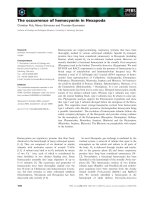
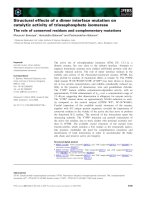
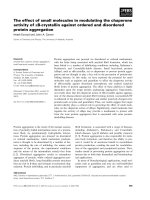
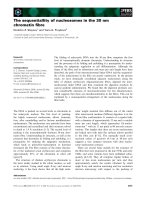
![Tài liệu Báo cáo khoa học: The stereochemistry of benzo[a]pyrene-2¢-deoxyguanosine adducts affects DNA methylation by SssI and HhaI DNA methyltransferases pptx](https://media.store123doc.com/images/document/14/br/gc/medium_Y97X8XlBli.jpg)
